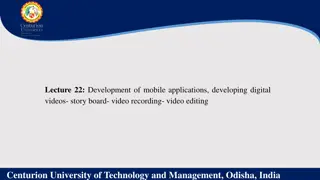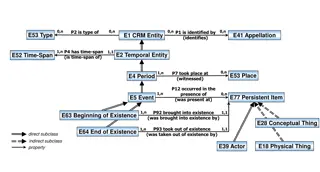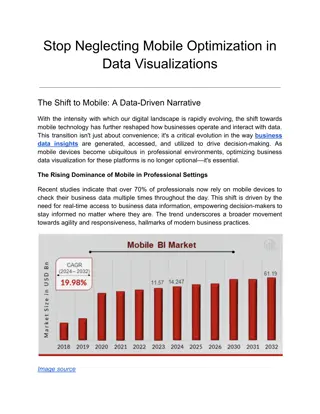Temporal Quality Assessment for Mobile Videos
This research focuses on developing a novel Temporal Variation Metric (TVM) to assess the temporal quality of mobile videos. The approach aims to accurately measure temporal information without the need for optical flow methods, making it suitable for embedded devices. The methodology, including the calculation of the Temporal Variation Index (TVI) and testing with various videos, demonstrates the effectiveness of the proposed metric in capturing temporal quality degradation and correlating with user Quality of Experience (QoE).
Download Presentation

Please find below an Image/Link to download the presentation.
The content on the website is provided AS IS for your information and personal use only. It may not be sold, licensed, or shared on other websites without obtaining consent from the author.If you encounter any issues during the download, it is possible that the publisher has removed the file from their server.
You are allowed to download the files provided on this website for personal or commercial use, subject to the condition that they are used lawfully. All files are the property of their respective owners.
The content on the website is provided AS IS for your information and personal use only. It may not be sold, licensed, or shared on other websites without obtaining consent from the author.
E N D
Presentation Transcript
Temporal Quality Assessment for Mobile Videos An (Jack) Chan, Amit Pande, Eilwoo Baik and Prasant Mohapatra University of California, Davis, CA 95616, USA {anch, pande, ebaik, pmohapatra}@ucdavis.edu
Introduction Video quality comprises of both spatial and temporal quality the temporal quality assessment cannot re-use the existing static image quality measurement techniques (e.g., PSNR, SSIM) Temporal Variation Metric (TVM) estimate the motion of objects in the video Temporal Variation Index (TVI) measures the temporal quality degradation between the source (original) and the received videos Mean Opinion Score (MOS)
Motivation Objective measurement of QoE Video temporal information optical flow or motion vectors is unsuitable for embedded devices Desired properties of a video quality metric Captures the degradation of the temporal quality Correlates with user QoE Low computational cost Codec independent Estimates the network impairments such as packet loss and delay Does not require the original copy of the video
Approach Temporal Variation Metric (TVM) compare the similarity of two neighboring (consecutive) frames of video to estimate the motion in video only record the average similarity score of a whole frame no-reference Temporal Variation Index (TVI) only needs the TVM of the original video
Measuring Temporal Information Temporal Variation Metric (TVM) use previous frame of the video as a reference and calculate temporal motion in the video indicator of motion or temporal variation in the current frame as compared with previous frame log of mean square value of difference between two consecutive frames (Fp 1 and Fp) of the video k is a constant for a video with a particular color depth d is the mean square difference of the corresponding pixels in two frames, Fp 1 and Fp
Testing with Videos six different videos
Testing with Videos optical flow is widely used to measure the actual temporal motion in a video both TVSNR and TVM have the highest correlation coefficients with the optical flow
Testing with Videos computation time required by those metrics on a 12GB 12-core Intel Xeon (dualcore) processor running Matlab release 2011
Testing with Videos different video content or degree of motion has no obvious effect on the memory requirements the resolution of the video greatly influences the memory overhead of temporal information measurements
Estimating Video Temporal quality Temporal Variation Index (TVI) estimate the temporal quality degradation by comparing the temporal information of the received video with that of the original video TVMr(t) is the TVM value for the received frame at current time TVMs(t) is the TVM value of the corresponding frame from the source video TVI values for some frames in the video are infinite
Subjective Experiments stream videos over wireless testbeds with different channel conditions three videos with different degrees of motion Old Woman(17), Park(17) and Football(16) 17 volunteers as subjects to watch the videos on the smartphone 10-second video clips
Estimating QoE Group the video samples to slow, moderate and fast TMOS is an objective video quality metric based on TVI TMOS is highly correlated with MOS with an average correlation coefficient of 0.925
Network Evaluation Experimental Setup a single-hop wireless testbed The WLAN configuration for the testbed is IEEE802.11n and the average minimum end-to-end delay is 0.604 milliseconds three representative videos, one for each motion degree (slow, moderate and fast) FFmpeg [6] for video coding and VideoLan [18] for video streaming IPFireWall tool [8] to deliberately introduce packet loss and delay into the wireless link Packet loss is injected as uniform distributed or as bursty pattern or a combination of both Delays are injected randomly
Detecting Packet Loss Vary the packet loss rate (PLR) from 0.1% to 3% for high-resolution videos and from 5% to 50% for low- resolution videos High resolution videos have larger spatial coding interdependencies than low-resolution videos
Detecting Packet Loss increasing PLR leads to higher TVI values, indicating larger temporal quality degradation
Predicting Packet Loss Rate when TVI value increases (including the number of INF increases), the packet loss rate also increases
Detecting and Predicting Delay In order to predict the delay effect, TVM values are calculated first in the receiver end
Detecting and Predicting Delay An prediction of end-to-end delay (D) can be obtained by counting these INFs
Conclusion proposed a novel reduced-reference temporal quality metric, Temporal Variation Index (TVI) for mobile videos TVI also predicts network impairments, such as packet loss and end-to-end delay Although temporal quality is a unique and important aspect for video, it is also very interesting to integrate TVI with other spatial quality metrics























